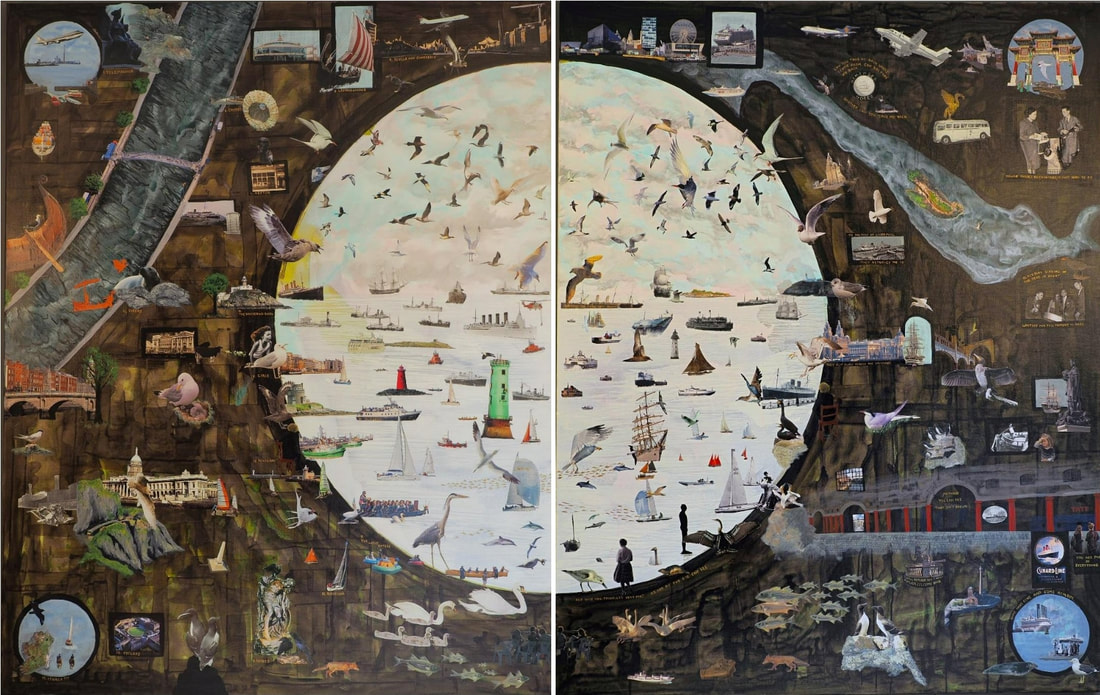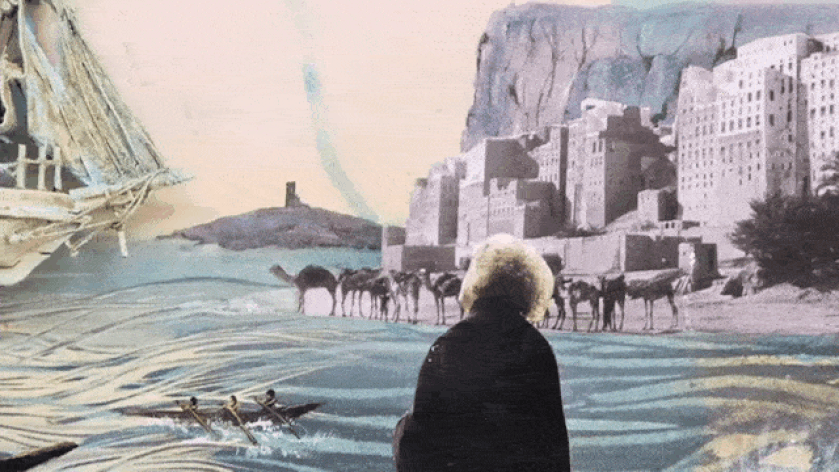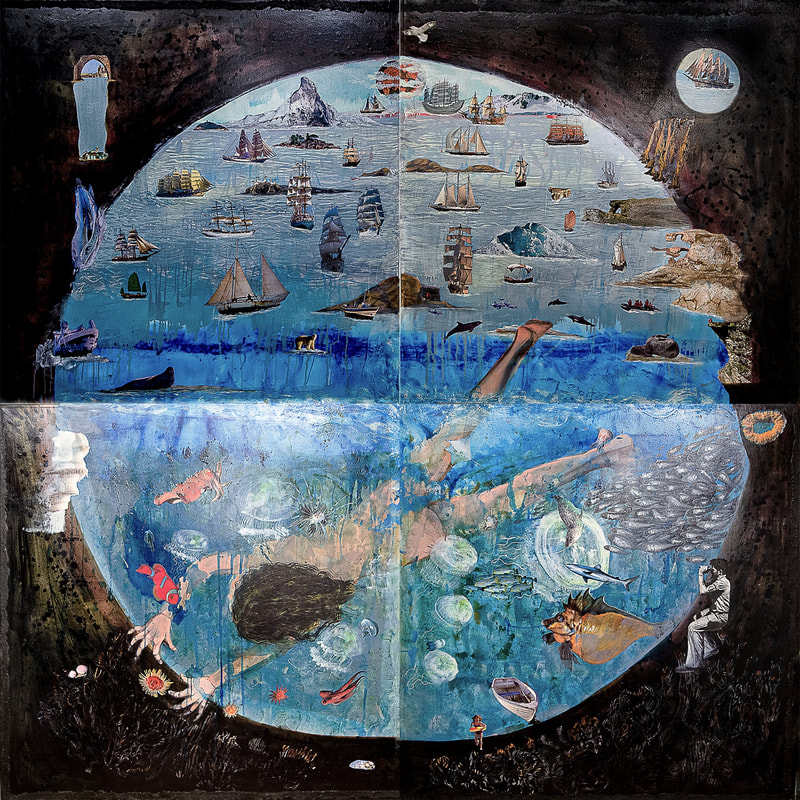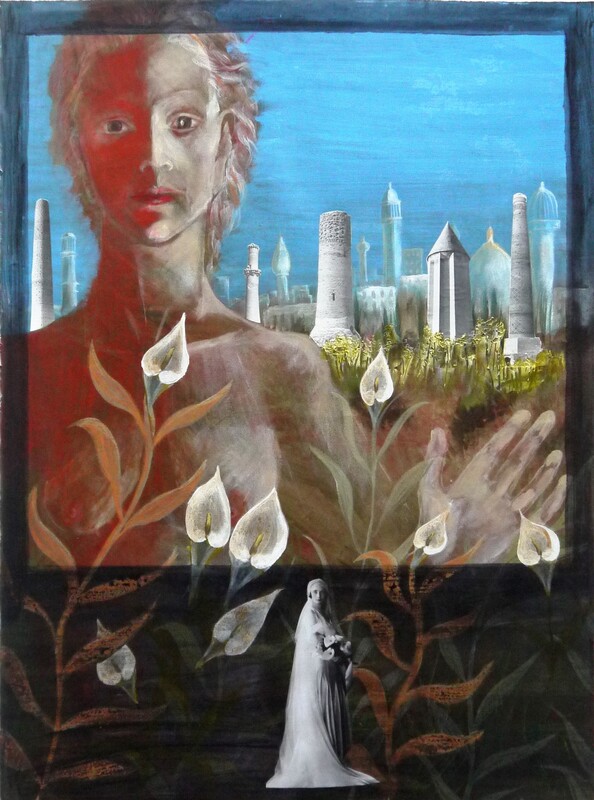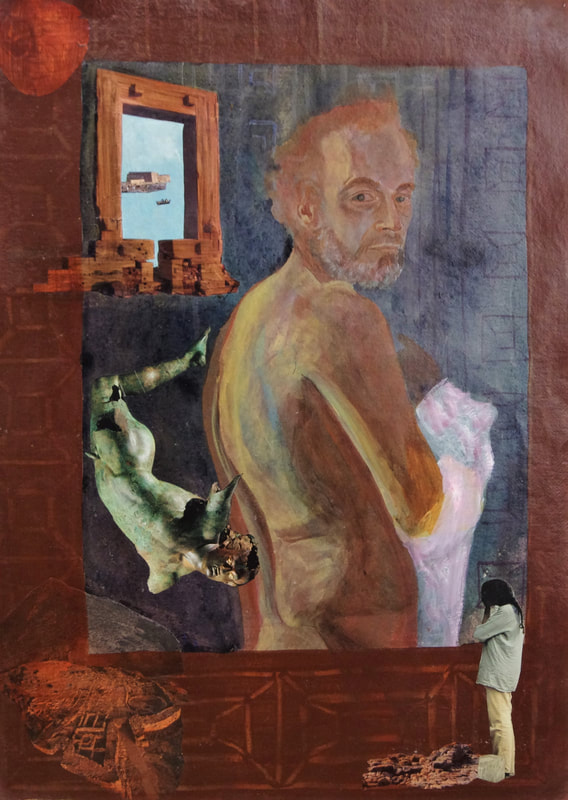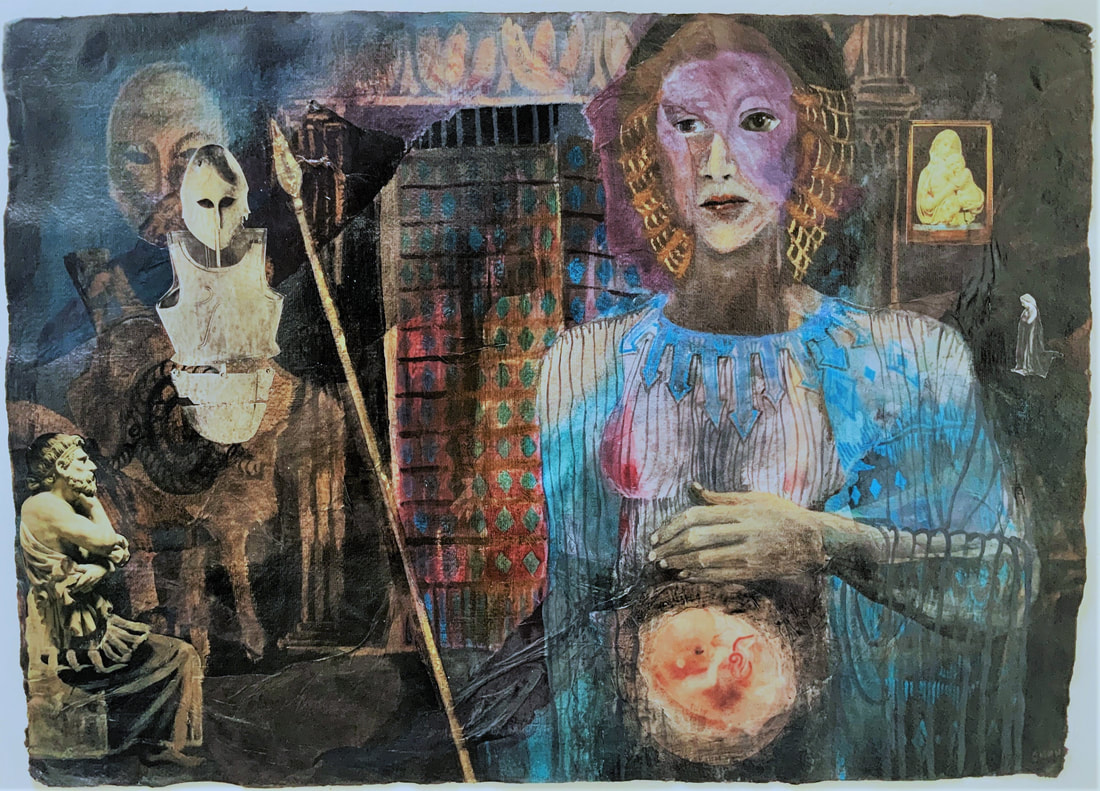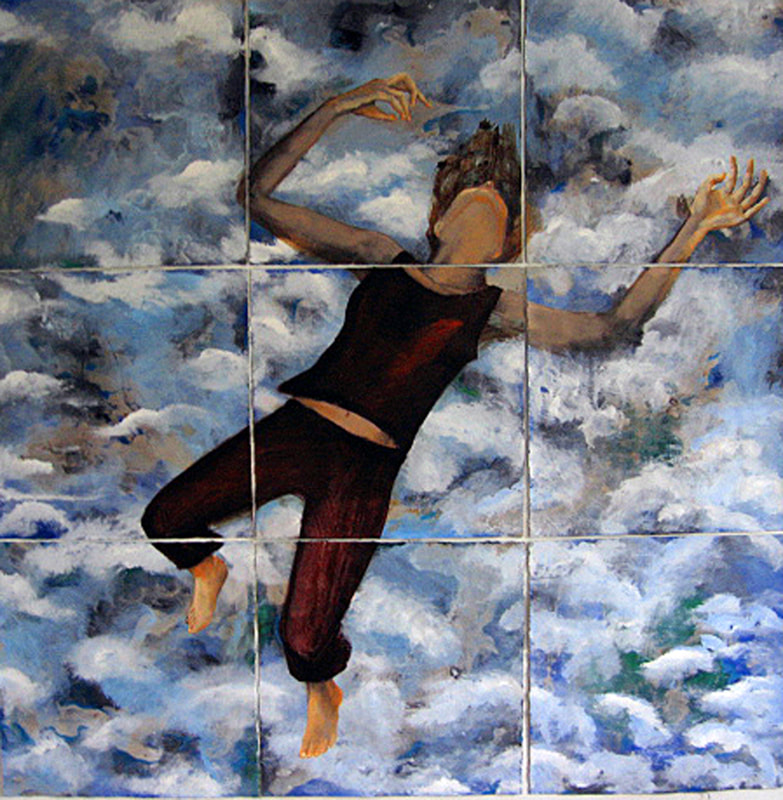|
In this ongoing body of work, artist Fion Gunn draws together several themes which have underpinned her artistic practice. She contemplates the movement of peoples across our planet, reflecting not just her ancestors’ and her own experience but encompassing the lived experience of all migrants both contemporaneously and historically. The story of the silk roads, spice routes, flotillas of trade and ideas is painted, stitched, collaged and built into these artworks.
Gunn revisits her childhood fascination with tales of exploration, of adventure and all too often, exploitation - Marco Polo, Robert Louis Stevenson’s Treasure Island, Dafoe’s Robinson Crusoe - intrigued by the ethical/moral decisions made by the heroes/ villains and the complex investigations of human morality made by Joseph Conrad in Lord Jim and the Heart of Darkness. The circular ‘window’ motif which recurs in her work is both a porthole into seascapes and a representation of the cycle of life, a cycle of evolving eras. In each window a new world is discovered and an old world remembered. The series continues in Gunn's VR creations because they represent her own exploration of immersive technologies. |
Cities
Like all the series Gunn works on, 'Cities' is ongoing and maybe that speaks to the obsessions we have from an early age that stay with us throughout our lives. Here are the stories for some of these works which describe her fascination with cities:
‘The Dreams of City Dwellers’ 2012 30 x 25 x 5cm, mixed media
"I made this artwork in response to working in Beiing. It is such a hardcore polluted urban environment and yet at the heart of Chinese culture is a profound feeling for the natural world, one which is layered with fantasy nowadays…. I used photos that I took at Jiangguomen, painted on them, added collage and a miniature bridge from which hang tiny scrolls of traditional Chinese landscapes. The piece is made inside a frame which was used to export a brick of Chinese tea more than 50 years ago and is a miniaturised 3D window into Beijing life as I have felt it."
The Hidden City # 2, 2023 acrylic, handmade paper, collage, gold leaf, 78x56cm
I made this artwork as a woman living in London and thinking about women all over the world, our shared and our differing experiences: the doors that open for us and those that shut us out, the windows we look through to imagine our place in the wider world. I have included quotations from writers - Toni Morrison, Eavan Boland and Emily Dickinson as a tribute to the light they shed on our hidden city and the impact their writing has had on me. I still “dwell in possibility”.
‘The Dreams of City Dwellers’ 2012 30 x 25 x 5cm, mixed media
"I made this artwork in response to working in Beiing. It is such a hardcore polluted urban environment and yet at the heart of Chinese culture is a profound feeling for the natural world, one which is layered with fantasy nowadays…. I used photos that I took at Jiangguomen, painted on them, added collage and a miniature bridge from which hang tiny scrolls of traditional Chinese landscapes. The piece is made inside a frame which was used to export a brick of Chinese tea more than 50 years ago and is a miniaturised 3D window into Beijing life as I have felt it."
The Hidden City # 2, 2023 acrylic, handmade paper, collage, gold leaf, 78x56cm
I made this artwork as a woman living in London and thinking about women all over the world, our shared and our differing experiences: the doors that open for us and those that shut us out, the windows we look through to imagine our place in the wider world. I have included quotations from writers - Toni Morrison, Eavan Boland and Emily Dickinson as a tribute to the light they shed on our hidden city and the impact their writing has had on me. I still “dwell in possibility”.
Bridge of Memory
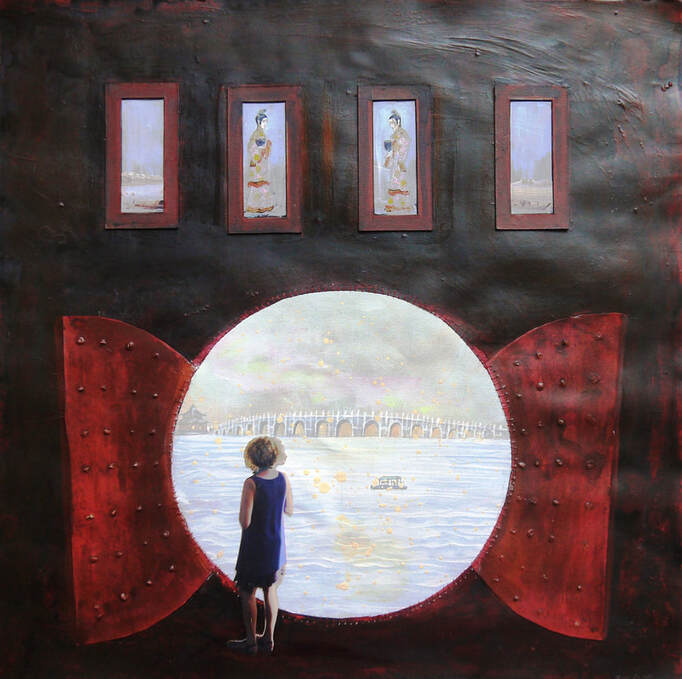 Remembering the Scribe 2017, paper,canvas,acrylic, collage, 57x57cm
Remembering the Scribe 2017, paper,canvas,acrylic, collage, 57x57cm
“To be ignorant of what occurred before you were born is to remain always a child. For what is the worth of human life, unless it is woven into the life of our ancestors by the records of history?” Marcus Tullius Cicero
In this ongoing series of work I draw heavily on my own lived experience, growing up over the family antique shop, where as a small child I played with a a Qing figure of a scribe (this was the subject of my first observational drawing when I was about 5 years old. I played with a miniature Chinese shipping fleet, carved in ivory and laid out in the shop window and I watched the boats sail in and out of Cork harbour from Cobh and Kinsale or walked along the dockside visiting ships and submarines that came to Cork from France, Greece, Russia and beyond. I imagined a life of journeying and adventure, I was never going to be the one who stayed at home.....
In 'Memories I have Desired' I create memories of idyllic childhood outings which never occurred, of course..... This is an ultimate wish fulfillment, visiting beautiful places with parents who are capable of getting you there without the dreadful fights, the car sickness, the bad food, the delayed departures and the arrival at destinations when the sun was already sinking along with the children's hearts!
THE PAINTED THREAD Exhibition - slide show below
Beijing, October 2016
Artists: Fion Gunn, Niamh Cunningham & Gulistan
Curated by Fion Gunn & Eric Liu
@ Yue PAVILION, Beijing 北京市朝阳区金汇路9号W109(世界城商业街 悦馆·观澜湖艺术生活空间
Full artist's text and essay by Harry Liu on Blog Page
The View from Mars
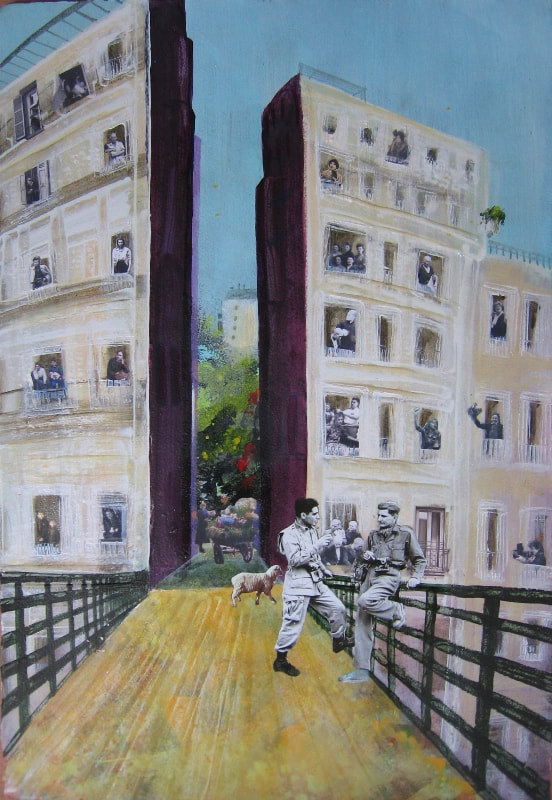
The View from Mars series explores the devastation of ordinary people - civilians in time of war, how we can live parallel lives with those who suffer without seeing, without recognising what is happening around us.
If we were Martians would we understand the brutality, the embracing of conflict in these wars of attrition? how would we interpret the seemingly arbitrary destruction of beautiful landscapes and ordinary people. which claimed so many of her compatriots.
The view of the Forbidden City was taken by the artist during her first trip to China in 2003 - from centre of power to tourist site in less than a century.....this work is a narrative of ambiguity.
The artist's most recent works look at the huge issue of 'displacement' - the ongoing creation of refugees. The collages feature images of our rich architectural legacy (one of the ways in which we define a 'civilisation', side by side with images from Syria and Gaza. Through these varied locations troop the displaced - Jewish, Syrian, Palestinian, Russian, Ukrainian.... carrying their children and dragging their baggage. History repeating itself mercilessly.
This first work in the series shows an image believed to be from circa 1910 of Korean 'Comfort Women' whom the Japanese Military (and many in contemporary Japanese society) claimed were 'paid prostitutes who earned a lot of money' alongside the image of a carefree young photographer in pre 1930 China not long before the Japanese massacres.
If we were Martians would we understand the brutality, the embracing of conflict in these wars of attrition? how would we interpret the seemingly arbitrary destruction of beautiful landscapes and ordinary people. which claimed so many of her compatriots.
The view of the Forbidden City was taken by the artist during her first trip to China in 2003 - from centre of power to tourist site in less than a century.....this work is a narrative of ambiguity.
The artist's most recent works look at the huge issue of 'displacement' - the ongoing creation of refugees. The collages feature images of our rich architectural legacy (one of the ways in which we define a 'civilisation', side by side with images from Syria and Gaza. Through these varied locations troop the displaced - Jewish, Syrian, Palestinian, Russian, Ukrainian.... carrying their children and dragging their baggage. History repeating itself mercilessly.
This first work in the series shows an image believed to be from circa 1910 of Korean 'Comfort Women' whom the Japanese Military (and many in contemporary Japanese society) claimed were 'paid prostitutes who earned a lot of money' alongside the image of a carefree young photographer in pre 1930 China not long before the Japanese massacres.
The Greek Cycle
Age of Uncertainty By series
As Woody Guthrie said “Life has got a habit of not standing hitched. You got to ride it like you find it. You got to change with it. If a day goes by that don't change some of your old notions for new ones, that is just about like trying to milk a dead cow.”
While we progress through this year, with global society in a state of flux, it is instructive to consider how we will move forward and have we learnt anything. For myself it has been and continues to be a highly productive time, a strange blend of creative energy, an intense desire to explore new ideas and methodologies and melancholia. So this series of work is my response to all these complex and shared feelings we have about connectivity/isolation, displacement/sense of place. For now plans range from from mixed media 2D to VR and film, more 3D work is planned and I am experimenting with sound and how to progress the sort of multimedia collage I find gripping.
While we progress through this year, with global society in a state of flux, it is instructive to consider how we will move forward and have we learnt anything. For myself it has been and continues to be a highly productive time, a strange blend of creative energy, an intense desire to explore new ideas and methodologies and melancholia. So this series of work is my response to all these complex and shared feelings we have about connectivity/isolation, displacement/sense of place. For now plans range from from mixed media 2D to VR and film, more 3D work is planned and I am experimenting with sound and how to progress the sort of multimedia collage I find gripping.
Falling, Jumping or Drowning....
In this series of works I use the image of falling as a metaphor for how we react to what happens in our lives – do we embrace it? do we fight against it? or do we just give up? This work runs parallel to the Drowning Series – when we drown, when we face death, do we run towards it or try to flee?
